TELEVISION REVIEW : Hedgecock Dull, Upstaged by Audience in TV Debut
- Share via
SAN DIEGO — The first half of the first installment of former Mayor Roger Hedgecock’s new television show was stupefyingly dull television. There should be a law forbidding Hedgecock to stand still and talk into a camera for more than 15 seconds at a time. It should be strictly enforced.
During the second half of the Sunday night show, though, something clicked--clicked to the point of almost being scary.
Naming San Diego’s new convention center after slain civil rights leader Martin Luther King Jr. was the topic of the audience-participation talk show in the now-traditional Phil-Oprah-Morton mold, which airs at 6 p.m. Sundays.
The program started moving when a white, middle-aged man in the audience stood up and said enough things had been named after “Dr. Luther King.” When the crowd booed, he angrily turned around and shouted, “Oh, baloney.”
Suddenly there was real tension in the studio, packed to overflowing, with some people standing in the aisles. Audience members started shouting at each other. A young black man angrily told Hedgecock that the “racist element” in the studio had prompted him to change his mind; he now favored naming the convention center after King.
Real emotion flowed in the studio. However, it soon seemed as if Hedgecock had lost control. Instead of talking through Hedgecock, the audience members were yelling at each other. The hysteria in the room was eerily reminiscent of a “Morton Downey Jr.” episode.
At one point, a white man continually accused the Rev. George Stevens, who spoke in favor of naming the convention center after King, of promoting racism as an issue. Stevens called the man a liar. With the man shouting at him, and Hedgecock offering little help, Stevens finally just shrugged. It had turned from a debate into a street-corner argument. “I don’t want to participate in this,” Stevens said.
It appeared there was real danger of violence breaking out. Although it made for bizarrely fascinating television, it was almost cliche in the era of “Geraldo.” It had reached that sad point when it seemed an audience member might actually pick up one of the folding chairs in the low-rent studio set and throw it across the room.
It all made for interesting television, in the same way riots and pro wrestling make for interesting television.
The rest of the show was basic Local Television Community Forum Program, circa 1972. Hedgecock’s opening monologues explaining the issues were overly long, tedious and pompous.
“At first I did not want to do this show,” Hedgecock explained.
The production staff was able to produce few visual elements to break up the show, except for one seemingly obligatory tacky visual of a newspaper headline, a roll-in of King’s famous “I have a dream” speech, and an equally obligatory “man on the street” segment, which consisted of two--count ‘em, two--interviews.
Clearly stiff and uncomfortable, trying hard to be a Professional Talk Show Host, Hedgecock showed little special ability in his first crack at the television host role. Billed in the introduction as “the man who knows San Diego best,” he displayed little special knowledge of the subject matter and was not exceptionally good at orchestrating the crowd.
In television, there is also the very real question of whether the audience will accept Hedgecock’s visual presence. He does show the effects of a teen-age skin problem, and he has a stiff, distant on-screen manner. Whenever he stood still and spoke directly into the camera, it was the equivalent of a clarion call to change the channel.
Only occasionally did he flash the acerbic ringmaster skills that have made his KSDO-AM (1130) radio show so popular. When he lashed out at people, directing them to get to the point, he gave the show a true spark.
“Wait, what you said at the beginning was dumbfounding,” he snapped at guest Robert Pruett.
Later he sounded more like Hedgecock the successful talk radio host when he calmed down a woman by telling her not to touch his microphone. A few minutes after that he turned to a man in the audience. “Excuse me, could you control your wife, sir.”
Whenever he asserted himself--”Just tell us what you believe, don’t look at your papers”--Hedgecock showed he could be entertaining in the host role. But he did little follow-up questioning, rarely displayed his own viewpoint, and seemed reluctant to push the show in any direction. He certainly never approached the prestated lofty goal of the show, to arrive at some consensus, or at least find “common ground.”
In the end the program revealed nothing except the hot emotions of the issue and the divisiveness. Hedgecock’s stiff editorializing at the end of the show--”If Martin Luther King was sitting in the back of this room, I don’t think he’d be very proud”--was not enough to give the show a real spark.
Hedgecock’s role seemed almost superfluous to the proceedings. In the end, the audience was the show.
More to Read
The complete guide to home viewing
Get Screen Gab for everything about the TV shows and streaming movies everyone’s talking about.
You may occasionally receive promotional content from the Los Angeles Times.






